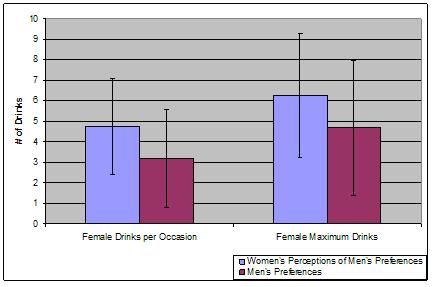The DRAM, Vol. 5(3) – College women trying to drink men under the table: The effects of reflective norms
Though men consume more alcohol than women, women’s alcohol intake has increased steadily during the past thirty years (Johnston, O’Malley, Bachman, & Schulenberg, 2007; Wechsler et al., 2002). Research has begun to explore unique influences on women’s consumption. This week’s DRAM reviews a study that explores the effects of reflective norms (i.e., individuals’ beliefs about what behaviors the opposite sex prefers them to do) on college women’s drinking behavior (LaBrie, Cail, Hummer, & Lac, 2009).
Methods:
- 3,616 college students (53.6% of the initial representative sample targeted for recruitment from two west coast universities) completed a Web-based survey.
- 62% of participants were female and 55% were White.
- The Web-based survey assessed:
- females’ perceptions of how much their male peers prefer females to drink (i.e., reflective norms),
- males’ self-report of how much they prefer females to drink, and
- females’ self-report of weekly alcohol consumption.
Results:
- Women significantly overestimated the amount of alcohol their male peers wanted them to drink; 71% of women estimated the preferred number of drinks to be more than the average male preference (see Figure).
- Women’s reflective norms positively correlated to their drinking behavior after controlling for demographics and perceived same-sex norms (i.e., beliefs about typical behavior of female peers).

Figure. Means of women’s perceived reflective normative preferences and men’s actual normative preferences (adapted from LaBrie et al., 2009). Click image to enlarge.
t’s(3615)=19.1 and 14.53, respectively, p’s < .001
Limitations:
- The data was obtained by self report.
- The study was cross-sectional; consequently, this research was not able to determine whether perceived norms influenced drinking or drinking influenced perceived norms.
Discussion:
The study suggests that women who drink more do so because they think their male peers prefer women to drink more. This motivation and misperception is particularly troubling because women are more likely than men to suffer sexual aggression while intoxicated (Parks & Fals-Stewart, 2004). College prevention programs should consider informing women about the disconnect between what they think men want and what men do want and address the dangers associated with drinking to impress one’s peers.
— Tasha Chandler
What do you think? Please use the comment link below to provide feedback on this article.
References:
Johnston, L., O’Malley, P., Bachman, J., & Schulenberg, J. E. (2007). Monitoring the future national survey results on drug use, 1975-2006: Volume II. College students and adults ages 19-45. Bethesda, MD: National Institute on Drug Abuse.
LaBrie, J., Cail, J., Hummer, J. F., & Lac, A. (2009). What men want: The role of reflective opposite-sex normative preferences in alcohol use among college women. Psychology of Addictive Behaviors, 23(1), 157-162.
O’Malley, P. M., & Johnston, L. D. (2002). Epidemiology of alcohol and other drug use among American college students. Journal of Studies on Alcohol – Supplement(14), 23-39.
Parks, K. A., & Fals-Stewart, W. (2004). The temporal relationship between college women’s alcohol consumption and victimization experiences. Alcoholism: Clinical and Experimental Research, 28(4), 625-629.
Wechsler, H., Lee, J. E., Kuo, M., Seibring, M., Nelson, T. F., & Lee, H. (2002). Trends in college binge drinking during a period of increased prevention efforts: Erratum. Journal of American College Health, 51, 37-37.